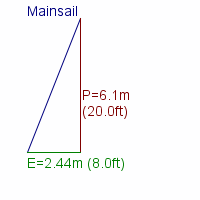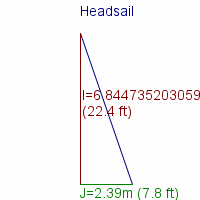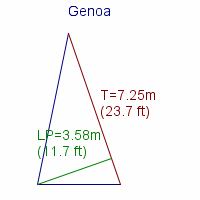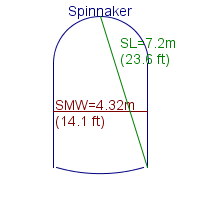Review of Stanley 19

Basic specs.

This boat is a result of a design-competition in 1962 arranged by the british tool manufacturer Stanley Works Ltd..
Looking for a new boat? Find a Stanley 19 or similar boat for saleBoth the hull and the deck is made of plywood.
The hull has chines which can provide increased initial stability. This means that the boat will resist rolling side to side, especially when at rest or cruising at slower speed. The chines can also help spray outwards keeping the deck drier when underway.

The boat is equipped with 4 berths.
Note: the boat has also been sold to be home-completed, which means that the quality of each boat may vary.

Stanley 19 has more than one rig.
One option is a masthead rig. The advantage of a masthead rig is its simplicity and the fact that a given sail area - compared with a fractional rig - can be carried lower and thus with less heeling moment.
Another option is a fractional rig. A fractional rig has smaller headsails which make tacking easier, which is an advantage for cruisers and racers, of course. The downside is that having the wind from behind often requires a gennaker or a spinnaker for optimal speed.

Fin keel
The Stanley 19 is built with a fin keel. A boat with a fin keel is more manoeuvrable but has less directional stability than a similar boat with a full keel.
The keel is made of iron. Many people prefer lead keel in favour of iron. The main argument is that lead is much heavier than iron and a lead keel can therefore be made smaller which again result in less wet surface, i.e. less drag. In fact iron is quite heavy, just 30% less heavy than lead, so the advantage of a lead keel is often overstated. As the surface of a fin type keel is just a fraction of the total wet surface, the additional surface area created by the cast iron keel in comparison to a lead keel of the same weight would be negligible for cruising yachts.
The boat can enter even shallow marinas as the draft is just about 0.91 - 1.01 meter (2.99 - 3.29 ft) dependent on the load. See immersion rate below.
The fuel tank has a capacity of 20 liters (5 US gallons, 4 imperial gallons).
An outboard motor is often used on this boat. In that case the boat will typically require a power of 2 - 3 hp, alternatively 33 - 40 lbs thrust if you prefer an electrical motor. Electric outboards are becoming popular for sailboat owners who want clean instant power with less noise and no exhaust fumes.
Sailing characteristics
This section covers widely used rules of thumb to describe the sailing characteristics. Please note that even though the calculations are correct, the interpretation of the results might not be valid for extreme boats.
What is Capsize Screening Formula (CSF)?
The capsize screening value for Stanley 19 is 2.31, indicating that this boat would not be accepted to participate in ocean races.
The immersion rate is defined as the weight required to sink the boat a certain level.
The immersion rate for Stanley 19 is about 80 kg/cm, alternatively 451 lbs/inch.
Meaning: if you load 80 kg cargo on the boat then it will sink 1 cm.
Alternatively, if you load 451 lbs cargo on the boat it will sink 1 inch.
Sailing statistics
This section is statistical comparison with similar boats of the same category. The basis of the following statistical computations is our unique database with more than 26,000 different boat types and 350,000 data points.
What is L/B (Length Beam Ratio)?
The l/b ratio for Stanley 19 is 2.78.
The ballast ratio for Stanley 19 is 31%.
What is SA/D (Sail Area Displacement ratio)?
The SA/D for Stanley 19 with ISO 8666 reference sail is 19.2, with a 135% genua the SA/D is 22.8.
What is Relative Speed Performance?
The Relative Speed Performance for Stanley 19 is 21
Angle of Vanishing Stability approximately equals 110 + ( 400 / (SSV-10) )
If you are planning to sail in heavy weather, you should be interested in the Angle of Vanishing Stability (AVS).
The boat has an calculated AVS of 56.34099250656462.
This indicates a boat suitable for calm water only.
ballastRatio: 0.30666666666666664
Displacement: 750.0
DraftHull: 0.61
Beam: 2.08
SSV: 2.545519966075858
AVS: 56.34099250656462
The displacement may vary, i.e. give an interval.
Maintenance
When buying anti-fouling bottom paint, it's nice to know how much to buy.
The surface of the wet bottom is about 11m2 (118 ft2).
Based on this, your favourite maritime shop can tell you the quantity you need.
Note: If you use a paint roller you will need more paint than if you use a paintbrush.
Dimensions of sail for masthead rig.




Are your sails worn out? You might find your next sail here: Sails for Sale
If you need to renew parts of your running rig and is not quite sure of the dimensions, you may find the estimates computed below useful.
| Masthead rig | ||||
| Usage | Length | Diameter | ||
| Mainsail halyard | 16.6 m | (54.3 feet) | 6 mm | (1/4 inch) |
| Jib/genoa halyard | 16.6 m | (54.3 feet) | 6 mm | (1/4 inch) |
| Spinnaker halyard | 16.6 m | (54.3 feet) | 6 mm | (1/4 inch) |
| Jib sheet | 5.8 m | (19.0 feet) | 8 mm | (5/16 inch) |
| Genoa sheet | 5.8 m | (19.0 feet) | 8 mm | (5/16 inch) |
| Mainsheet | 14.5 m | (47.5 feet) | 8 mm | (5/16 inch) |
| Spinnaker sheet | 12.7 m | (41.8 feet) | 8 mm | (5/16 inch) |
| Cunningham | 2.4 m | (8.0 feet) | 6 mm | (1/4 inch) |
| Kickingstrap | 4.9 m | (16.0 feet) | 6 mm | (1/4 inch) |
| Clew-outhaul | 4.9 m | (16.0 feet) | 6 mm | (1/4 inch) |
| Fractional rig | ||||
| Usage | Length | Diameter | ||
| Mainsail halyard | 17.3 m | (56.8 feet) | 6 mm | (1/4 inch) |
| Jib/genoa halyard | 17.3 m | (56.8 feet) | 6 mm | (1/4 inch) |
| Spinnaker halyard | 17.3 m | (56.8 feet) | 6 mm | (1/4 inch) |
| Jib sheet | 5.8 m | (19.0 feet) | 8 mm | (5/16 inch) |
| Genoa sheet | 5.8 m | (19.0 feet) | 8 mm | (5/16 inch) |
| Mainsheet | 14.5 m | (47.5 feet) | 8 mm | (5/16 inch) |
| Spinnaker sheet | 12.7 m | (41.8 feet) | 8 mm | (5/16 inch) |
| Cunningham | 3.0 m | (9.7 feet) | 6 mm | (1/4 inch) |
| Kickingstrap | 5.9 m | (19.4 feet) | 6 mm | (1/4 inch) |
| Clew-outhaul | 5.9 m | (19.4 feet) | 6 mm | (1/4 inch) |
This section is reserved boat owner's modifications, improvements, etc. Here you might find (or contribute with) inspiration for your boat.
Do you have changes/improvements you would like to share? Upload a photo and describe what you have done.
We are always looking for new photos. If you can contribute with photos for Stanley 19 it would be a great help.
If you have any comments to the review, improvement suggestions, or the like, feel free to contact us. Criticism helps us to improve.
